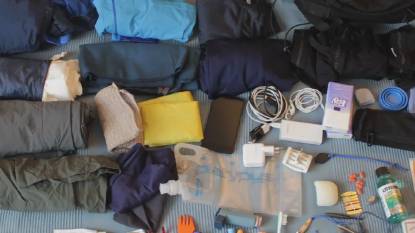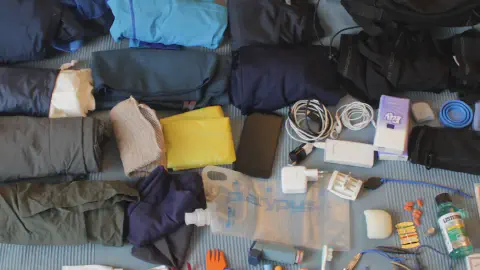
My Camino Packing List PDF Download and Guide
Posted: | Updated:
Reading time: 22 minutes
My Camino Packing List PDF Download and Guide
Posted: | Updated:
Reading time: 22 minutes
By: Simon Kemp, Editor
Download your free Camino Packing list PDF and use this Camino packing guide to create your own personal checklist. I’ve listed the most important and essential items for the journey so you don’t make the mistake of over-packing.
If you are short on time then simply scroll to the bottom of this page to download your packing list.
So you think you know hiking? Understand a thing or two about going on a long walking holiday? Walking the Camino will make you believe that you are a novice who has never been hiking before! The Camino is the challenge of all challenges when it comes to multi-day hiking trips so it’s good to take a note from people who have done the trip several times before.
Key Takeaways
Remember, the Camino de Santiago is not just a physical journey, but also a mental and emotional one. The items you carry with you can significantly impact your overall experience. A well-planned packing list can help you enjoy the journey to its fullest.
Embrace Minimalism on the Camino de Santiago
When preparing for the Camino de Santiago, it’s essential to embrace a minimalist approach. Overpacking can lead to discomfort and unnecessary strain. The philosophy of packing light and smart is central to the Camino experience. It’s not just about reducing weight, but also about freeing yourself from the burden of ‘stuff’ and realizing that you can thrive with much less than you think.
Support Local Economies Along the Way
Another aspect of the Camino packing philosophy is supporting local economies. Instead of packing everything you might need, consider buying some items along the way. This approach not only reduces the weight of your backpack but also supports the local economy, contributing to the towns and villages that support pilgrims on their journey.
Adapt Your Packing List to the Season
The Camino de Santiago can be walked at any time of the year, but your packing list will need to be adjusted depending on the season. Whether it’s spring, summer, autumn, or winter, each season requires different clothing and gear to ensure comfort and safety on the trail.
Choose the Right Backpack and Pack Efficiently
Choosing the right backpack and knowing how to pack it efficiently are crucial aspects of your Camino de Santiago preparation. A backpack with a capacity of 30 to 40 liters is usually sufficient. Heavier items should be packed towards the middle of the backpack and close to your back, while lighter items should be packed towards the top and bottom.
Stay Hydrated and Nourished
Staying hydrated and nourished is crucial on the Camino. A reusable water bottle or hydration bladder is a must. While you can buy food along the way, it’s a good idea to have some snacks on hand for when hunger strikes. Energy bars, nuts, and dried fruit are good options.
Pack Right for the Camino
Embarking on the Camino de Santiago is not just a journey through the picturesque landscapes of Spain, but also a test of one’s preparation and adaptability. One of the most crucial aspects of this preparation is packing. What you carry in your backpack can significantly impact your experience on the trail, influencing not only your comfort but also your ability to meet the challenges of the Camino.
The importance of a well-planned packing list cannot be overstated. Imagine walking under the scorching sun, your backpack chafing against your shoulders, filled with items you haven’t used even once. Or picture yourself shivering in the cold, regretting that you didn’t pack that extra layer of clothing. These scenarios underline why it’s essential to pack not just light, but smart.
This guide aims to help you create a comprehensive and practical packing list for the Camino de Santiago. It’s based on the wisdom gathered from numerous pilgrims who have walked the path before, as well as my own, learning through trial and error what’s necessary, what’s optional, and what’s better left at home.
We’ll look into the philosophy of minimalist packing, a concept that encourages carrying only what’s essential. We’ll discuss why it’s beneficial to purchase items locally, supporting the economies of the towns you pass through, and adding to the authenticity of your Camino experience. For instance, instead of carrying a large tube of toothpaste, why not buy a small one from a local store in Saint-Jean-Pied-de-Port and replenish it as needed along the way?
From clothing and toiletries to electronics and food, we’ll break down each category, providing detailed explanations and specific recommendations. We’ll also discuss how to adapt your packing list checklist based on the season and share tips on selecting the right backpack and packing it effectively.
Remember, the Camino de Santiago is not just a physical journey, but a metaphor for life . And just like in life, carrying unnecessary baggage can weigh you down. So let’s start this journey on the right foot, with a well-packed backpack and an open heart.
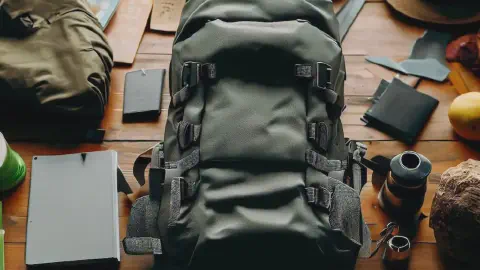
The Philosophy of Packing for the Camino
The Camino de Santiago is not just a long walk across Spain ; it’s an opportunity to embrace simplicity and self-reliance. This philosophy extends to what you carry in your backpack. The idea is not just to pack light, but to pack smart, carrying only what is necessary and leaving behind what is not.
Minimalist Packing
Minimalist packing is about more than just reducing weight. It’s about freeing yourself from the burden of ‘stuff.’ It’s about realizing that you can survive – and thrive – with much less than you think.
Consider clothing, for example. You might be tempted to pack a fresh outfit for each day of the week, but in reality, you only need two sets of clothes: one to wear and one to wash. This approach not only saves space and weight but also simplifies your daily routine. You won’t waste time each morning deciding what to wear – you’ll simply put on your clean set of clothes and start walking.
The same principle applies to other items. Do you need a full-sized towel? Probably not. A quick-drying microfiber towel will do the job and take up less space. Do you need a different pair of shoes for every possible terrain? Again, probably not. A good pair of well-broken-in hiking boots should suffice for most of the trail.
When creating your personal camino packing list checklist, one of the most important things to remember is to pack light. In many ways it is far better to have too little stuff than too much. Laundry facilities are available at many refuges along the way and there are many villages on the journey with small stores to buy essential items like toothpaste.
I cannot stress this enough: It is vitally important that you take the absolute minimum amount of stuff with you in your backpack. Everybody takes too much and almost always end up sending it home or forward to Santiago in the mail or even just discarding it.
It is surprising just how little you really need to take as the shops in Spain are now very good and have all the “modern” stuff that people want such as Shaving Cream, or Suntan Lotion. You really don’t need to take those things with you, so they are not on my Camino packing list, just buy them as you need them.
Personally I prefer to do it this way since it keeps the local economy running as well as keeping the backpack lighter. Some local communities seem to rely on the pilgrims walking through for their lively-hood. Some, on the other hand, hide their shops for the use of the locals only. You need to search out those sometimes when a town or village appears to have no shops.
That said, I do like to take a good book or two, even though they add weight. You may find, like I do, that you have a lot of time for reading while resting along the way.
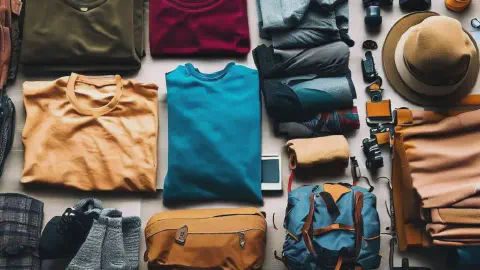
Supporting Local Economies
Another aspect of the packing philosophy for the Camino is the idea of supporting local economies. This means, instead of packing everything you might need, consider buying some items along the way.
For instance, instead of carrying a month’s supply of soap or sunscreen, why not buy these items from local stores along the route? This approach has several benefits. Firstly, it reduces the weight of your backpack. Secondly, it supports the local economy, contributing to the towns and villages that support pilgrims on their journey. And finally, it adds to the adventure and authenticity of your Camino experience. There’s something special about buying fresh bread from a bakery in a small Spanish town, or finding a unique souvenir in a local artisan shop.
This approach requires a degree of flexibility and trust. You have to trust that you’ll find what you need when you need it. But that’s part of the Camino experience – learning to trust the journey and go with the flow.
In conclusion, the philosophy of packing for the Camino de Santiago is about embracing simplicity, supporting local communities, and trusting the journey. It’s about carrying what you need, and nothing more. It’s about lightening your load, in more ways than one.
Detailed Camino Packing List
Creating a detailed packing list for the Camino de Santiago involves considering various categories of items, from clothing and toiletries to electronics and food. Here, we’ll break down each category, providing detailed explanations and specific recommendations.
Clothing
When it comes to clothing, the key is to think in layers and versatility. The weather on the Camino can be unpredictable, so you’ll want to be prepared for a range of conditions.
- Base Layer: This includes underwear and socks. Opt for moisture-wicking and quick-drying materials. For example, merino wool is a popular choice for socks due to its breathability and natural anti-odor properties. You’ll need two pairs of each – one to wear and one to wash.
- Middle Layer: This includes your main items of clothing like shirts and pants. Again, choose lightweight, quick-drying materials. Consider convertible hiking pants that can be turned into shorts, offering flexibility for changing weather conditions.
- Outer Layer: This includes a waterproof and windproof jacket. Even in summer, rain showers can occur, and the wind can be chilly, especially in the mornings and evenings.
- Shoes: A good pair of hiking boots is essential. They should be well broken in to avoid blisters. Also, consider a pair of lightweight sandals or flip-flops for the evenings when you want to let your feet breathe.
Toiletries and Personal Items
For toiletries, the goal is to keep things minimal and eco-friendly.
- Hygiene Items: This includes a toothbrush, small tube of toothpaste, and a razor if needed. For soap, consider a biodegradable all-purpose soap that can be used for body, hair, and even clothes.
- First Aid Kit: Include basic items like band-aids, antiseptic wipes, tweezers, and any personal medication. Also consider including Compeed or another type of blister treatment – a common issue for Camino walkers.
- Sun Protection: A small tube of sunscreen, a hat, and sunglasses will help protect you from the sun.
Electronic Devices
The Camino de Santiago is a chance to disconnect, but some electronics can be useful.
- Phone: Useful for emergencies, taking photos, and staying in touch with family and friends. Consider downloading offline maps or a Camino app for navigation.
- Charger and Adapter: Remember that Spain uses Type F power sockets, so you may need an adapter. A portable power bank can also be useful for times when a power outlet isn’t available.
- Headlamp: Useful for early morning starts or finding your way around an albergue in the dark.
On the subject of electronics, I would definitely discourage that as it’s a distraction, One refuge I stayed at, a guy had his mobile phone with him and it would ring all the time, even during the night. He was not a popular guy the next day, I can tell you. If the electronic items are valuable then you will be worrying about them being stolen and in any case one of the ideas of the camino is to get away from the modern world a little.
Of course you could say that I ignored my own advice, but I walked the second camino with a specific intent to get the sounds and photographs and needed that equipment to do it. But as I had the gear on me all the time in case of hearing a spontaneous sound or picture then I didn’t have to worry about anything been stolen. I never worried about that anyway.
Food and Water
Staying hydrated and nourished is crucial on the Camino.
- Water Bottle: A reusable water bottle or hydration bladder is a must. Tap water in Spain is generally safe to drink, and there are many fountains along the way.
- Snacks: While you can buy food along the way, it’s a good idea to have some snacks on hand for when hunger strikes. Energy bars, nuts, and dried fruit are good options.
Remember, this list is a guide and should be adapted to your personal needs and preferences. The Camino de Santiago is a unique experience for each pilgrim, and so is the process of preparing for it.
Hydration
I would recommend that you drink at least 3 litres of fresh water every day. It is very easy to become dehydrated on the Camino, particularly on the meseta and drinking coffee or soft drinks is not a suitable substitute as it dehydrates you. So for every “Grande Café Con Leche”, you need another 1/3 liter of fresh water later to compensate! A real shame as I adore Spanish coffee (big sigh) and it’s one of the main “luxuries” I don’t want to do without when walking the Camino. I looked forward to my first coffee every single day.
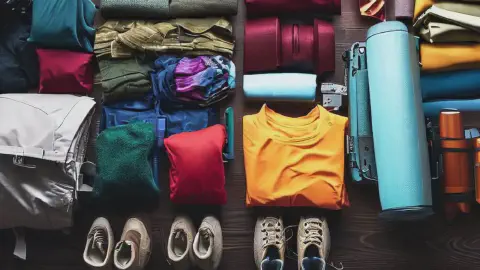
Packing for Different Seasons
The Camino de Santiago can be walked at any time of the year, but your packing list will need to be adjusted depending on the season. Here’s a breakdown of what you might need to consider for each season:
Spring and Autumn
Spring (March to May) and Autumn (September to November) are popular times to walk the Camino due to milder temperatures and less crowded paths. However, these seasons can also be unpredictable, with a mix of warm days, cold nights, and occasional rain showers.
- Clothing: Layering is key during these seasons. Pack lightweight, breathable clothing that can be easily layered. Include a warm fleece or lightweight down jacket for colder mornings and evenings, and a waterproof jacket for rainy days. In general, for clothes, take two pairs of everything, one to wear and one in the wash or drying on the back of your backpack.
- Footwear: Waterproof hiking boots are a good idea, as you may encounter wet conditions.
- Accessories: Don’t forget a hat and gloves for colder days, and a lightweight scarf or buff can be versatile.
Summer
Summer (June to August) on the Camino can be hot, especially in the afternoons. Some parts of the trail offer little shade, so sun protection is crucial.
- Clothing: Opt for lightweight, breathable, and moisture-wicking fabrics to keep you cool. Consider clothing with UPF (Ultraviolet Protection Factor) for added sun protection.
- Footwear: Breathable hiking boots or shoes are important to prevent your feet from overheating. Some pilgrims prefer hiking sandals in the heat, but make sure they offer good support and protection.
- Accessories: A wide-brimmed hat, sunglasses, and high-SPF sunscreen are essential. Also consider a bandana or neck gaiter that can be soaked in water and worn around the neck to help keep you cool.
Winter
Winter (December to February) is the least crowded time to walk the Camino, but it also presents the most challenges in terms of weather, with cold temperatures, rain, and even snow in some areas.
- Clothing: Pack warm layers, such as thermal underwear, a fleece jacket, and a warm, waterproof outer layer. Don’t forget warm socks!
- Footwear: Waterproof and insulated hiking boots are a must. Gaiters can also be useful to keep snow and rain out of your boots.
- Accessories: A warm hat, gloves, and a scarf are essential. A good quality, lightweight thermal blanket could be a lifesaver in an emergency.
Remember, no matter the season, always check the weather forecast before you start your journey and be prepared for changeable conditions. The Camino de Santiago offers a different experience in each season, and being well-prepared will help you enjoy the journey to its fullest.
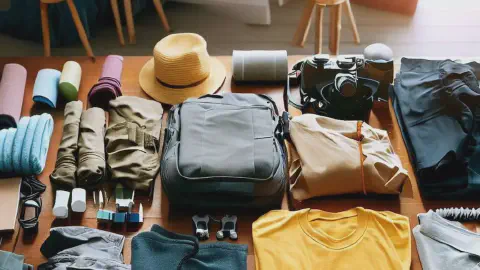
Backpack Selection and Packing Techniques
Choosing the right backpack and knowing how to pack it efficiently are crucial aspects of your Camino de Santiago preparation. Here’s a detailed guide to help you make the right choices.
Backpack Selection
The backpack you choose for the Camino de Santiago should be comfortable, durable, and just the right size. Here are some factors to consider:
- Size: A common mistake is to choose a backpack that’s too large. A bigger backpack might seem like a good idea, but it often leads to overpacking and a heavier load. For the Camino, a backpack with a capacity of 30 to 40 liters is usually sufficient.
- Fit: The backpack should fit well on your back. It should sit comfortably on your hips, and the shoulder straps should not dig into your shoulders. Many outdoor stores offer professional fitting services, which can be very helpful.
- Features: Look for a backpack with a good rain cover, multiple compartments for easy organization, and external loops or straps to attach items like a sleeping bag or walking poles.
Packing Techniques
How you pack your backpack can affect your comfort and ease of access to your items. Here are some tips:
- Weight Distribution: Heavier items should be packed towards the middle of the backpack and close to your back. This helps to maintain your center of gravity and makes the load feel less heavy. Lighter items should be packed towards the top and bottom.
- Organization: Use packing cubes or ziplock bags to organize your items. This not only makes it easier to find what you need but also helps to keep your items dry in case of rain.
- Essentials: Keep essential items like water, snacks, map, and rain gear in easily accessible pockets.
- Clothing: Roll your clothes instead of folding them. This saves space and helps to prevent wrinkles.
Here’s an example of how you might pack your backpack:
- Bottom of the Backpack: Lightweight items that you won’t need until the end of the day, like your sleeping bag and evening clothes.
- Middle of the Backpack: Heavier items like your toiletry bag and any additional clothing layers.
- Top of the Backpack: Items you might need quick access to during the day, like your rain gear, hat, and first aid kit.
- Outer Pockets: Water bottle, snacks, map, sunscreen, and other essentials.
Remember, packing for the Camino de Santiago is a personal process, and it might take some trial and error to find what works best for you. Practice packing and adjusting your backpack before you start your journey, and don’t be afraid to repack or adjust things along the way.
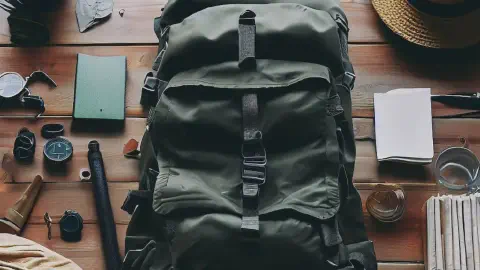
The Best Camino Packing List
- Boots – Good ones, well worn in
- Wool Socks – 2 pairs
- Thin Socks – 2 pairs (to wear inside the thick ones)
- Light T-shirt for the day
- Heavier shirt for the evening
- Trousers – 2 Pairs (The ones with the detachable shorts and legs).
- Light shoes for the evening to give your feet and boots a rest.
- Shower sandals. (Could combine with the above)
- Toothbrush
- Aeroplane style toothpaste (very small)
- Sleeping Bag
- Paperwork (Passport, money, credit card, credential, maps)
- Belly pouch or fanny pack (to ut all the paperwork n)
- Wide brimmed Hat
- Sunglasses
- Sun screen (very important!)
- Personal Toilet Items (you decide)
- Shampoo – does for everything, washing hair and clothes.
- Lightweight backpack
- Water Bottle (sometimes it is a long way between fountains)
- Wet weather gear, poncho, waterproof trousers. (vital for Galicia!)
That’s It!
That lot shouldn’t add up to more than 10KG and one of the heaviest items, the shoes, you will be wearing without noticing the weight.
In Conclusion
In conclusion, preparing a well-thought-out packing list for the Camino de Santiago is a crucial step in your journey. It’s not just about having the right items with you, but also about understanding the philosophy behind each choice you make.
Remember, the Camino is not just a physical journey, but also a mental and emotional one. The items you carry with you can significantly impact your overall experience. For instance, packing light can make your journey more comfortable and less strenuous, allowing you to focus more on the beautiful surroundings and less on the weight on your back.
Consider the example of clothing. The “two pairs of everything” rule isn’t just about having a backup. It’s about ensuring that you can always have a clean, dry set of clothes to wear while the other is being washed or dried. This can make a huge difference in your comfort and hygiene during the trip.
The same goes for toiletries and personal items. Choosing multi-purpose items like shampoo that can also be used to wash clothes, or eco-friendly toiletries that reduce your environmental impact, are decisions that reflect not just practicality, but also your respect for the environment and the local communities you’ll be visiting.
When it comes to electronics, remember that the Camino is an opportunity to disconnect from the digital world and connect more deeply with yourself and the world around you. While it might be tempting to bring all your gadgets, consider the value of leaving some of them behind.
As for food and water, remember that hydration and nutrition are key to maintaining your energy and health during the hike. But also remember that part of the Camino experience is enjoying the local cuisine and supporting the local economy. So, instead of packing all your food from home, consider buying from local stores along the way.
Lastly, remember that your packing list should be adapted to your personal needs and preferences, as well as the specific season during which you’ll be walking the Camino. What works for one person might not work for another, and what works in summer might not work in winter. So take the time to research, plan, and prepare.
In the end, the most important thing is that you feel prepared and confident as you embark on this incredible journey. The Camino de Santiago is not just about reaching the destination, but also about enjoying the journey. And a well-planned packing list can help you do just that.
We hope this article has been helpful and we encourage you to share your own tips and experiences in the comments section below. Buen Camino!
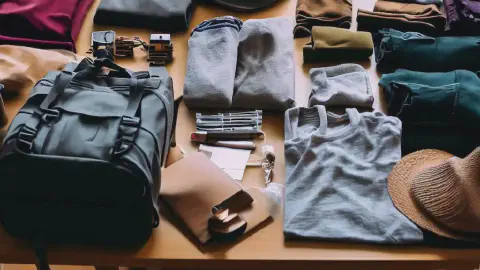
Get Your Free Camino de Santiago Packing List PDF!
We know how daunting it can be to prepare for a journey like the Camino de Santiago. There’s so much to consider, especially when it comes to packing. What do you bring? What do you leave behind? How do you make sure you have everything you need without overloading your backpack?
To help you navigate these questions, we’ve created a comprehensive Packing List Guide for the Camino de Santiago. This guide is the result of countless hours of research, personal experience, and feedback from many pilgrims who have walked the Camino. It’s designed to help you prepare effectively for your journey, ensuring you have all the essentials without unnecessary extras.
The best part? We’re offering this guide including a packing list Checklist as a free PDF download!
How to Get Your Free Guide
Getting your free Camino de Santiago Packing List Guide is easy. All you need to do is sign up for our mailing list. Here’s how:
- Scroll to the bottom of this page.
- You’ll find a sign-up form for our mailing list. Enter your details in the provided fields.
- Click the “Send it now!” button to submit the form
- Once you’ve signed up, you’ll receive a confirmation email with a link to download your free Packing List Guide.
That’s it! Four simple steps to get your comprehensive guide to packing for the Camino de Santiago.
Why Sign Up for Our Mailing List?
By signing up for our mailing list, not only will you get your free Packing List Guide, but you’ll also receive regular updates, tips, and insights about the Camino de Santiago. We share personal stories, practical advice, and the latest news to help you prepare for your journey. And don’t worry, we respect your inbox and promise to only send you relevant and valuable content. You can unsubscribe at any time.
So, what are you waiting for? Sign up today, get your free Packing List Guide, and take the first step towards a successful Camino de Santiago journey. Buen Camino!
Camino Packing List FAQ’s
- What is the importance of packing light for the Camino de Santiago?
Packing light for the Camino de Santiago is crucial to ensure comfort and ease during the journey. Overpacking can lead to unnecessary strain and discomfort, detracting from the overall experience. The guide recommends a minimalist approach, carrying only essential items and supporting local economies by purchasing items along the way. - What is the recommended clothing for the Camino de Santiago?
The recommended clothing for the Camino de Santiago includes a base layer of moisture-wicking underwear and socks, a middle layer of lightweight, quick-drying shirts and pants, and an outer layer of a waterproof and windproof jacket. It’s also recommended to have a good pair of hiking boots and a pair of lightweight sandals or flip-flops for the evenings. - How should I pack for different seasons on the Camino de Santiago?
The packing list for the Camino de Santiago should be adjusted depending on the season. For Spring and Autumn, layering is key. For Summer, opt for lightweight, breathable, and moisture-wicking fabrics. For Winter, pack warm layers, such as thermal underwear, a fleece jacket, and a warm, waterproof outer layer. - What are the recommended toiletries and personal items for the Camino de Santiago?
The recommended toiletries and personal items for the Camino de Santiago include a toothbrush, small tube of toothpaste, a razor if needed, a biodegradable all-purpose soap, a basic first aid kit, and sun protection items like a small tube of sunscreen, a hat, and sunglasses. - What electronic devices are recommended for the Camino de Santiago?
While the Camino de Santiago is a chance to disconnect, some electronics can be useful. These include a phone for emergencies, taking photos, and staying in touch with family and friends, a charger and adapter, and a headlamp for early morning starts or finding your way around an albergue in the dark. - How should I select and pack my backpack for the Camino de Santiago?
The backpack for the Camino de Santiago should be comfortable, durable, and of the right size, typically with a capacity of 30 to 40 liters. Heavier items should be packed towards the middle of the backpack and close to your back, while lighter items should be packed towards the top and bottom. Essential items like water, snacks, map, and rain gear should be kept in easily accessible pockets. - How can I get a free Camino de Santiago Packing List PDF?
You can get a free Camino de Santiago Packing List PDF by signing up for the mailing list on the website. After confirming your subscription, you’ll receive a second email with a link to download your free Packing List Guide.

